#eiko kadono
Photo


Kiki’s Delivery Service (1989)
dir. Hayao Miyazaki
#Kiki's Delivery Service#hayao miyazaki#literature#eiko kadono#ours#by tanya#filmedit#filmgifs#moviegifs#fyeahmovies#userfilm#animationedit#filmtvanimals#ghibliedit#usersavana#chewieblog#duchessofhastings#userkraina#uservintage#animationsdaily
3K notes
·
View notes
Text

💖✨️Rose's Last Book Haul of 2023 ✨️💖
#book haul#book stacks#book photography#barnes & noble#brandon sanderson#terry pratchett#rainer maria rilke#kelly barnhill#eiko kadono#jen wang#mamoru hosoda#not out of void but out of chaos
23 notes
·
View notes
Text
I completely forgot I could post craft stuff so here's this book rebinding I did like a month ago:
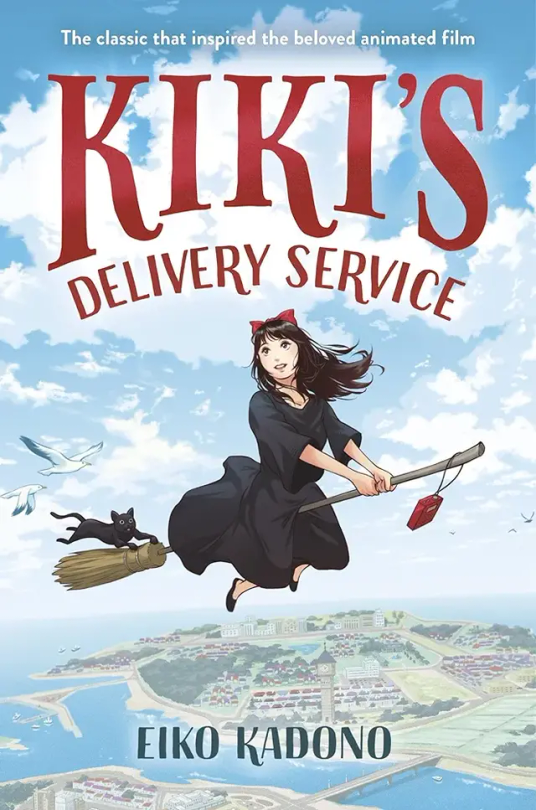
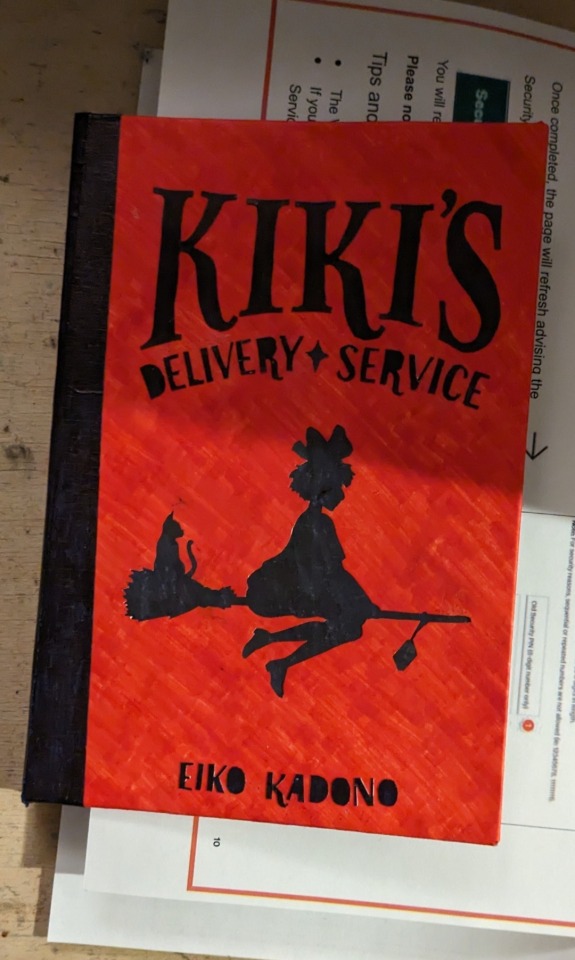
also the aftermath:

and the tutorial I used is here
I only used parts of it tho. I didn't feel like making an actual spine so I used painters tape and sharpie. I also ran out of white glue a quarter of the way through so for most of it I ended up using a gluestick and superglue. worked out nicely tho because then I could keep working without having to take breaks waiting for glue to dry. the cover isn't printed like in the tutorial either. it's layers of marker colored cardstock over a cover I cut off of an old school notebook (the one on the floor). I drew and cut out the silhouette of kiki myself. I also liked the lettering in the original cover so I cut those out too and glued them on. I also cut out eiko kadonos author picture, glued it to the back, and rewrote the "about the author" bit under it. the inside of the covers is black to match the spine and lettering.
all in all I don't think I did too bad for my first try at bookbinding. with materials I had at home no less.
it took about 10 hours in total not including weighing it down overnight
#I may or may not anger someone with this post#sorry in advance#bookbinding#kiki's delivery service#eiko kadono#craft project#studio ghibli#hayao miyazaki
12 notes
·
View notes
Quote
… but humans are so quick to decide that anything they don’t understand is evil.
Eiko Kadono, Kiki’s Delivery Service (translated by Emily Balistrieri)
160 notes
·
View notes
Text

Title: Kiki's Delivery Service | Author: Eiko Kadono | Publisher: Delacorte Press (2020)
37 notes
·
View notes
Text






Kiki's Delivery Service by Eiko Kadono
Published: June 1, 2021
Publisher: Sourcebooks Fire
The Author
Eiko Kadono is a Japanese author and has published nearly two hundred original works, most of which are books for children. In 1985, she published the children's novel Majo no Takkyūbin, which was later adapted into the Hayao Miyazaki animated film with the same title. Both the novel and the film are known by the English title Kiki's Delivery Service. The book was awarded the Hans Christian Andersen Award, among others, and she followed on this success with four sequels in the same series. She lives in the Kanagawa prefecture of Japan.
˗ˏˋ ´ˎ˗
The Story
Half-witch Kiki never runs from a challenge. So when her thirteenth birthday arrives, she's eager to follow a witch's tradition: choose a new town to call home for one year. Brimming with confidence, Kiki flies to the seaside village of Koriko and expects that her powers will easily bring happiness to the townspeople. But gaining the trust of the locals is trickier than she expected. With her faithful, wise-cracking black cat, Jiji, by her side, Kiki forges new friendships and builds her inner strength, ultimately realizing that magic can be found in even the most ordinary places.
˗ˏˋ ´ˎ˗
The Vibe: coming of age, whimsical, cosy, episodic adventures, wholesome, quirky, comfort read
The Style: japanese translation, children's literature, middle grade, chapter book, cute illustrations
Trigger Warnings: none
˗ˏˋ ´ˎ˗
The Review
Writing this review in 2024, I'd be surprised if you hadn't already seen, or at the very least heard of, Studio Ghibli's 1989 film Kiki's Delivery Service. As with all Ghibli movies, it is a lovingly animated piece with quirky characters and a wonderful soundtrack. Less people may be aware that, rather than being an original screenplay, the movie was based off the 1985 children’s novel of the same name.
According to Kadono, the story itself was inspired by a drawing her daughter drew of a witch flying through the sky with a radio, musical notes dancing around her. When creating Kiki, Kadono framed the character around her own daughter, who was also 12-years-old at the time. Drawing inspiration from her own daughter definitely brought life to Kiki, who experiences thoughts and feelings that all young girls go through in a considered and realistic way. I feel that this is the true heart of the story, and is why it touched so many people when it hit the big screen. The book itself is written for Middle Grade readers, and is a very simple story that adult readers could knock out in a day.
“I want everything to be brand-new - my clothes, my shoes, my broom, too. I want to be reborn. I’m sure Mom’ll say, ‘You’re from a long line of witches, so you need to value the old.” But I’m me. I’m a new witch.”
As with the film adaptation, the novel starts with Kiki preparing to leave home for her “Coming-of-Age” day, an event which kick-starts the year of mandatory independence that every 13 year-old witch is required to undertake. (It gives me a Pokémon vibe; how such young characters are encouraged to leave home to undertake some huge adventure on their own.) Kiki is confident in herself in the way only a child could be. She’s ready to start her life on her terms, but over the course of the story she begins to grow and experience cute developmental moments that show that she is moving on from childhood and becoming more knowledgeable about the world around her. These moments really show Kadono’s understanding of young girls like her daughter. Kiki begins to have doubts and questions about how things work as she settles in her new town, but still manages to make herself a little home above a shop owned by the lovely Osono, a friendly and heavily pregnant baker. If more people were like Osono, maybe kids could actually have more wholesome adventures out in the world??
How can I discuss Kiki without talking about her familiar, the black cat, Jiji? Within the lore of the book, a new-born witches’ mother searches for a black kitten born around the same time as her daughter, so that they can be raised together (super cute!). As they grow, they develop a special relationship and learn to communicate in their own language that no one else can understand. It turns out that Jiji is particularly sassy and can be a little cranky, but always comes through for Kiki when she needs help. While he can talk, Jiji is very much a cat, “Jiji shot her a reproachful glance and then made up his mind to ignore her altogether.” If you liked Jiji in the movie, you won’t be disappointed in his book counterpart; he’s just the best, and a good companion for Kiki as she sets off into the world on her Coming-of-Age day.
“Gradually, everyone’s waving hands below grew harder to see, and all the lights of the town twinkled like a starry night turned upside down. The full moon hung in the sky, watching over Kiki. Eventually even the lights of the town faded, and all she could see below were mountains shaped like the dark backs of animals.”
Kiki chooses to settle in a seaside town called Koriko, and most of the novel focuses around her living in Osono’s spare room and running “Kiki’s Delivery Service”, her own small business. She meets a whole bunch of unusual characters, some of whom would fit perfectly into a Roald Dahl story. Her slow ingratiation into the hearts of the town is well done, considering the episodic nature of each chapter and the simplistic narration. In the witchy tradition of Kadono’s universe, Kiki doesn’t accept payments for her deliveries; she takes small things in return like food or being taught a new skill. In this way, she grows as a person and becomes more self-sufficient, while still experiencing typical tween-girl issues like dealing with crushes, “Mysterious? Is that how I’m supposed to act? Maybe there’s something wrong with me?” The book walks the fine line between simple writing and slightly deeper exploration of Kiki’s character extremely well.
While the film is very faithful to the core characters, especially Kiki, Jiji and Osono, there are a number of plot differences in the book. The young painter who lives in the woods is there, although she doesn’t play as large of a role in the novel. Tombo is also a side character, and while he is still a friend of Kiki’s there are a few major differences in his storyline, although they still have a cute, innocent courtship. The novel gives more emphasis to the various jobs that Kiki completes in her career as a flying courier, and no major crisis of confidence occurs that causes Kiki to forget how to fly her broom or talk to Jiji. Like I said, this is a children’s book, and even small amounts of movie melancholy aren’t present; it’s sweet and heart-warming rather than inserting drama for the narrative’s sake.
“Kiki, make sure you come back, all right? We’re so happy to have a witch as our neighbor. Everyone says that if they go three days without seeing you flying through the sky, they feel like something is missing.”
If you’re a big fan of the Studio Ghibli film, this book is worth checking out, if only to spend a little bit more time seeing Jiji being the sass master that he is, but remember that it is very much a children’s book and therefore a super simple read. I would definitely recommend it for younger readers, particularly if they enjoy stories like The Worst Witch by Jill Murphy. Kiki’s Delivery Service is very cosy and wholesome; if you feel like reading the book equivalent of a hot chocolate on a cold day, it’s one for you.
Rating: 🌕🌕🌕🌑🌑
[Goodreads]
#Kiki's Delivery Service#Eiko Kadono#Majo no Takkyūbin#Studio Ghibli#book review#bookblr#reading#books#witch fiction#witches#witchy#witchblr#witchy books#witchcore#witchy vibes#witch#witch books#ghiblicore#ghibli aesthetic#jiji
7 notes
·
View notes
Text
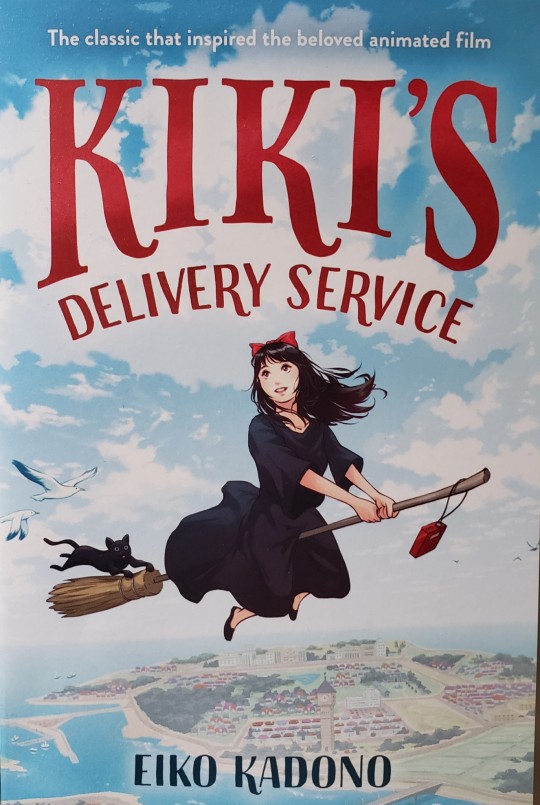
Kiki's Delivery Service
Story: Eiko Kadono -- Art: Yuta Onoda -- Translation: Emily Balistrieri
(original edition: 1985 -- this edition: 2020)

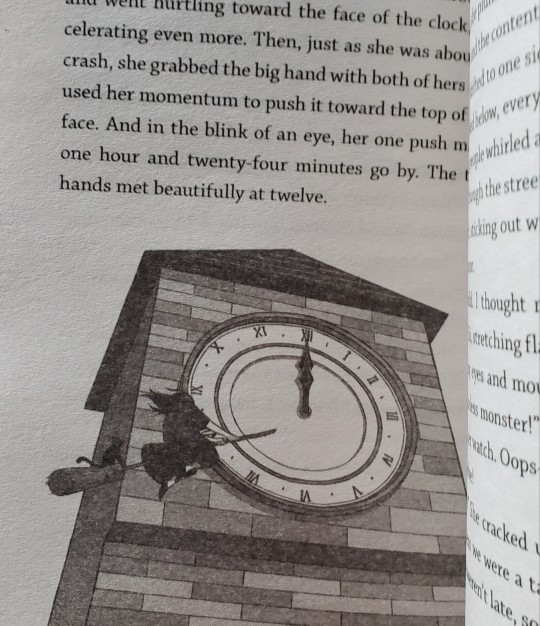
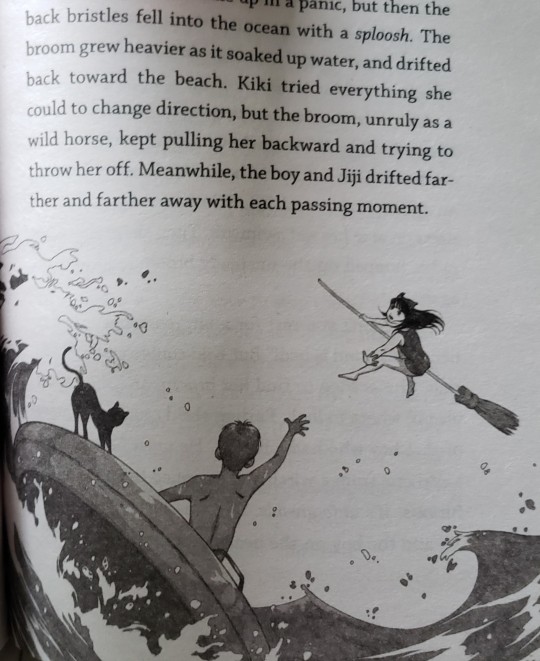
#kiki's delivery service#ghibli#1980s#80s#2020s#20s#eiko kadono#yuta onoda#chapter books#kid novels#children's novels#kid books#kidlit#children's books#children's literature#witches#magic#black cat#broomstick#i really hope they translate more books in this series this was adorable
96 notes
·
View notes
Text
Kiki's Delivery Service (1989)
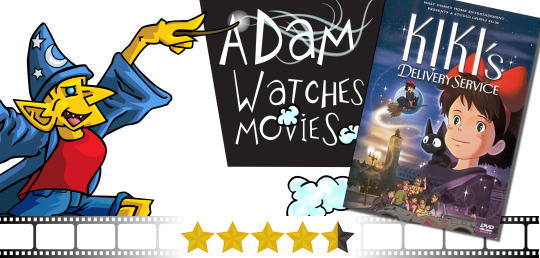
From its premise, Kiki’s Delivery Service sounds like the perfect film to keep young children quiet while you finish that big project due tomorrow. It isn’t; not really. Although children are sure to love it, only older viewers will understand its introspective themes and fully appreciate its story and visuals.
As she turns thirteen, Kiki (voiced by Minami Takayama, Lisa Michelson or Kirsten Dunst depending on the version you see) leaves home with her broom and animal companion - a black cat named Jiji (Rei Sakuma, Kerrigan Mahan or Phil Hartman) - to learn the ways of the world. Arriving via broomstick to the port city of Koriko, Kiki initially struggles to find her place until she opens a delivery service with the help of baker Osono (Keiko Toda, Alexandra Kenworthy, or Tress MacNeille).
There’s a fair amount of humor as Kiki misplaces a toy she's delivering for a birthday, is courted by a young airplane enthusiast (Kappei Yamaguchi, Eddie Frierson, or Matthew Lawrence) and struggles with the unique challenges that accompany a young witch in a big city. But this is not a comedy. Is it an adventure? No. There is no villain after Kiki’s powers, the snooty older witch Kiki meets on the way to Koriko doesn’t come back to fight her. There’s nothing like that. This is a coming-of-age drama and much of what we see are metaphors as Kiki - like many young women - realizes that leaving your parent’s house is a big step in figuring out what kind of person you will become. She thought she was going to spend all day zipping between buildings on her broom, but mostly, she's cleaning, waiting for orders to come in, figuring out what to charge for her work and realizing that she can put in a superhuman effort to make sure the job gets done right but hardly receive even a thank you. Kiki’s Delivery Service is about Kiki finding herself, figuring out what role she will fulfill in society and where she belongs.
It’s better to know this isn’t a fast-paced barrel of laughs or a syringe of adrenaline pumped into your veins before hitting 'play' on your remote. The earlier you realize what you’re in for, the more you’ll appreciate the story’s relaxing pace. Kiki does a lot of thinking on this journey and the time she spends gazing at the clouds or contemplating what’s next allows you to do the same. You get to fully enjoy the scenery and gorgeous visuals. You find the time to think about the choices Kiki makes as she prepares for her day, what it means to her when she misses an appointment and how the people she meets will influence her future.
Kiki’s Delivery Service is lovely because it never tries to be anything but itself. Life-defining issues are dealt with in a way that makes them fresh without diminishing or trivializing their importance to teens and young adults. You could also completely miss the more thoughtful aspects of this tale and enjoy it as a lighthearted tale about a young witch growing up. The marvelous traditional animation - a trademark of Studio Ghibli - makes it a joy to simply watch. Though you wouldn’t think it considering its relatively low-key story, Kiki’s Delivery Service makes a big impact. (English Dub, October 16, 2020)

#Kiki's Delivery Service#movies#films#animated movies#animated films#hayao miyazaki#studio ghibli#eiko kadono#minami takayama#rei sakuma#kappei yamaguchi#1989 movies#1989 films#tress macneille#kirsten dunst#phil hartman#matthew lawrence#eddie frierson#alexandra kenworthy#kerrigan mahan#lisa michelson
7 notes
·
View notes
Text

Kiki's Delivery Service - Eiko Kadono
Translation: Emily Balistrieri
Read: Apr 2023
I really, really love the Studio Ghibli film of this book. So when I saw the book in a local book store I jumped at it. I was very interested to read the source material. Now Kadono wrote this for her young daughter so it is truly a children's book. The flavour of it is different than the film, but the similarities are still there. There is a lot more material in the book and a lot of it felt childish. I guess that was to be expected from a children's book. It has been so long since I read a children's book that I'm not really used to reading writing for children. I enjoyed this book, it was fun to read, but in the end I felt the film did a better job with the story and with the character of Kiki.
Info: Yearling, 2020; originally: Majyo no Takkyubin, Fukuinkan Shoten, 1985
10 notes
·
View notes
Text
instagram
Kiki's Delivery Service by Eiko Kadono. I love love love the Studio Ghibli movie and so far loving the book. It is for younger readers but idc 💓 I love annotating, and I've doing it with this book as well as adding stickers.
#booklr#flowers#kiki's delivery service#studio ghilibi#witches#magic#reading is enchanting#book review#bookstagram#library#book tbr#book recommendations#bookworm#books#eiko kadono#libros#Instagram
8 notes
·
View notes
Text

Kiki's Delivery Service, Eiko Kadono
2 notes
·
View notes
Text

#jiji#kiki and jiji#kikis delivery service#hayao miyazaki#eiko kadono#miyazaki hayao#studio ghibli#studio ghibli films#black cat#phil hartman
2 notes
·
View notes
Text

“Kiki don't get too hung up on appearances, it's your heart that's important”
― Eiko Kadono, Kiki's Delivery Service
#Kiki's Delivery Service#Eiko Kadono#books#book photography#current reading#Not out of void but out of chaos
18 notes
·
View notes
Text
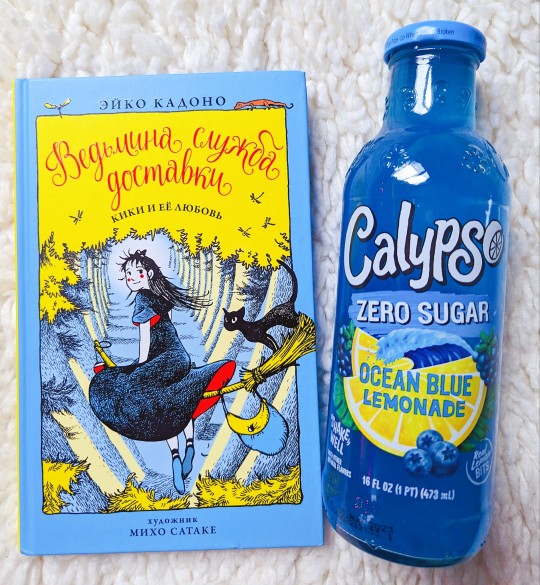
Закончила четвертую книгу - "Ведьмина служба доставки. Кики и её любовь".
Она лучше предыдущей, но я потихоньку теряю интерес к этой истории. Некоторые вещи меня раздражают, а персонажи ведут себя не логично и глупо. Кики повзрослела, и у неё другие заботы и увлечения, признаюсь, что маленькой она нравилась мне больше.
Впереди ещё четыре книги, но я прервусь на прочтение манги.
#what utoshi reading#books#book worm#book lover#книжный маньяк#kiki's delivery service#eiko kadono#drinks
17 notes
·
View notes
Text
Reading Resolution: “Kiki’s Delivery Service” by Eiko Kadono
18. A children’s book: Kiki’s Delivery Service by Eiko Kadono
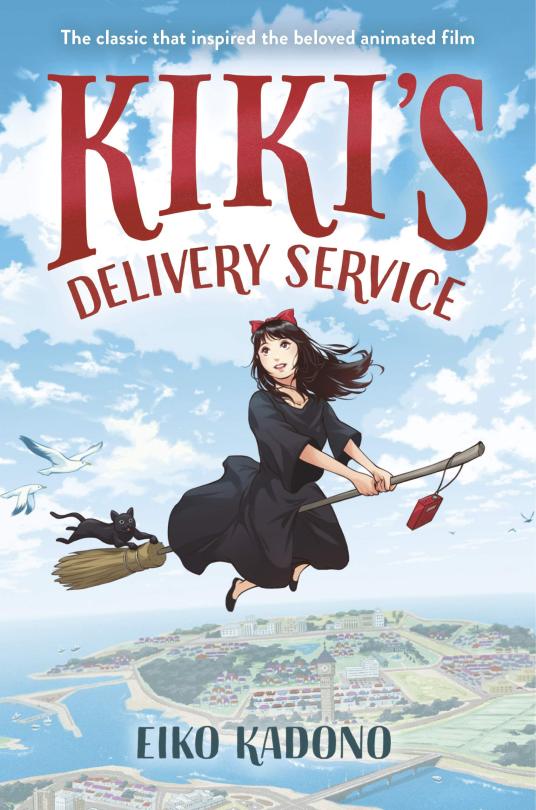
List Progress: 24/30
There is something special about children’s stories that are not just about one big adventure. Adulthood is not a single obstacle to overcome and be done with; it’s a collection of choices and challenges and successes and struggles that happen every day over years and years. The 1985 Japanese novel Kiki’s Delivery Service, by Eiko Kadono, is magical, about a young witch using her flying broom to make her way in the world, but it is also delightfully mundane. The story follows Kiki from her thirteenth birthday, when young witches set out on their own to prove themselves, through her first year on her own. There are ups and downs and plenty of beginnings, but perhaps most importantly, there are no endings. Just days, followed by more days.
Most Western audiences will know Kiki’s Delivery Service from the 1989 Hayao Miyazaki adaptation of the same name. While the quiet, wistful tone of the story is maintained, the film did have to conform the story to a more conventional movie narrative structure (which is not a criticism, just the nature of adaptations). The novel is largely made up of a series of vignettes, around different jobs that Kiki takes on, delivering things by broomstick around the seaside metropolis that she has made her home. She is not trying to accomplish any larger grand mission, just to figure out how to be an adult figure in a variable world. The only bit of home she has brought with her is her talking black cat Jiji, so it is up to her to make friends and navigate new relationships. And that can be a challenge, because Kiki is not always pleasant or optimistic. The book makes it clear that everyone has bad days, and there are just some times when Kiki is going to be grumpy or annoyed for no good reason, and that is also something to be navigated.
These sound like obvious lessons, but Kadono’s story lays them out gently and smoothly, with Kiki and Jiji feeling like real, rounded characters. Kiki’s Delivery Service teaches that life can be difficult and that there will be struggles along the way, but that they can be worked through and learned from. There is no finish line, but enjoying the flight along the way can be just as much of a victory.
Would I Recommend It: Yes. The 2020 English translation by Emily Balistrieri and illustrated by Yuta Onoda is very sweet.
45 notes
·
View notes
Quote
I don’t think it’s the world’s fault that magic disappeared. Maybe people hold themselves back too much. Mom, aren’t you always saying that witches must be quiet and modest? I hate the idea of living my life constantly worrying about what people will say—I’m going to do whatever I want!
Eiko Kadono, Kiki’s Delivery Service (translated by Emily Balistrieri)
26 notes
·
View notes